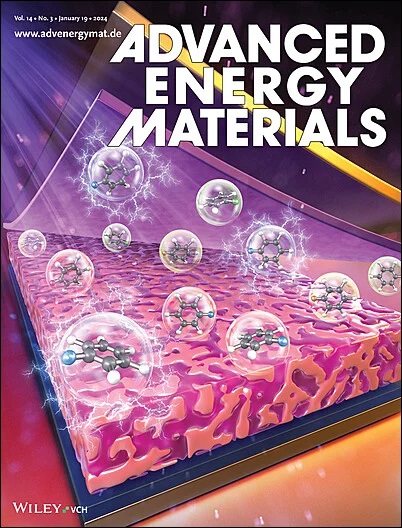Magnesium Oxide Buffer Layer for Over 32% Efficiency Four-Terminal Perovskite/Silicon Tandem Solar Cells
IF 24.4
1区 材料科学
Q1 CHEMISTRY, PHYSICAL
引用次数: 0
Abstract
Perovskite/silicon tandem solar cells have emerged as a promising candidate for next-generation photovoltaics, offering a pathway to surpass the efficiency limits of single-junction devices. However, the integration of a buffer layer between the electron transport layer and the transparent electrode is critical for maintaining structural integrity and optimizing charge extraction and stability. Here, the fabrication of a chemically stable and multifunctional buffer layer, magnesium oxide (MgOx), via thermal evaporation is demonstrated in four-terminal perovskite/silicon tandem solar cells. The introduction of MgOx enhances electron extraction while effectively mitigating damage caused by the sputtering process used for subsequent layers. As a result, the optimized device achieves a power conversion efficiency exceeding 32%, along with exceptional operational stability, MgOx device retains 80% of its initial efficiency after 400 h of continuous MPPT testing. This work highlights the pivotal role of buffer layer engineering in advancing high-performance tandem solar cells and provides a scalable route toward efficient and durable perovskite/silicon photovoltaics.

氧化镁缓冲层用于效率超过32%的四端钙钛矿/硅串联太阳能电池
钙钛矿/硅串联太阳能电池已经成为下一代光伏电池的有希望的候选者,提供了超越单结设备效率限制的途径。然而,在电子传输层和透明电极之间集成缓冲层对于保持结构完整性和优化电荷提取和稳定性至关重要。在这里,通过热蒸发在四端钙钛矿/硅串联太阳能电池中制备了化学稳定的多功能缓冲层氧化镁(MgOx)。MgOx的引入增强了电子提取,同时有效地减轻了后续层中使用的溅射过程所造成的损害。结果,优化后的MgOx器件的功率转换效率超过32%,并且具有优异的运行稳定性,MgOx器件在连续MPPT测试400 h后仍保持80%的初始效率。这项工作强调了缓冲层工程在推进高性能串联太阳能电池中的关键作用,并为高效耐用的钙钛矿/硅光伏电池提供了一条可扩展的途径。
本文章由计算机程序翻译,如有差异,请以英文原文为准。
求助全文
约1分钟内获得全文
求助全文
来源期刊

Advanced Energy Materials
CHEMISTRY, PHYSICAL-ENERGY & FUELS
CiteScore
41.90
自引率
4.00%
发文量
889
审稿时长
1.4 months
期刊介绍:
Established in 2011, Advanced Energy Materials is an international, interdisciplinary, English-language journal that focuses on materials used in energy harvesting, conversion, and storage. It is regarded as a top-quality journal alongside Advanced Materials, Advanced Functional Materials, and Small.
With a 2022 Impact Factor of 27.8, Advanced Energy Materials is considered a prime source for the best energy-related research. The journal covers a wide range of topics in energy-related research, including organic and inorganic photovoltaics, batteries and supercapacitors, fuel cells, hydrogen generation and storage, thermoelectrics, water splitting and photocatalysis, solar fuels and thermosolar power, magnetocalorics, and piezoelectronics.
The readership of Advanced Energy Materials includes materials scientists, chemists, physicists, and engineers in both academia and industry. The journal is indexed in various databases and collections, such as Advanced Technologies & Aerospace Database, FIZ Karlsruhe, INSPEC (IET), Science Citation Index Expanded, Technology Collection, and Web of Science, among others.
 求助内容:
求助内容: 应助结果提醒方式:
应助结果提醒方式:


